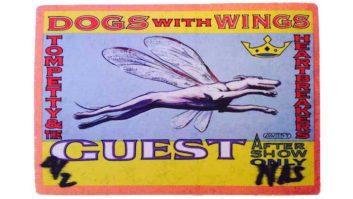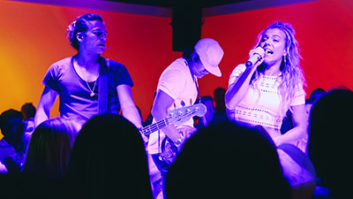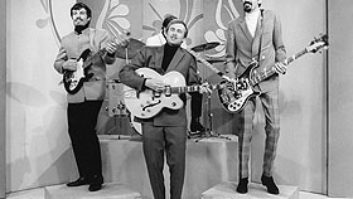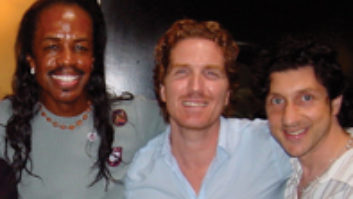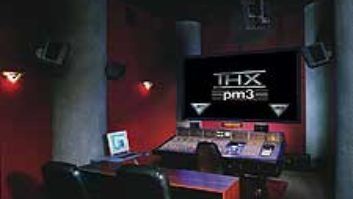Contrary to oft-heard complaints, there’s plenty of really good music out there. It’s just that most of it has a hard time getting heard. Any new music venue that offers a place for exposure is, as Martha Stewart used to say, “a good thing.” When that new venue offers easy access, comfortable seating, gourmet food and high-end sound — including one of the first surround sound systems ever installed in a club — well, what’s not to like?
Platinum Live is the latest incarnation of a club that originally opened in 1939 and has, over the years, hosted everything from cabaret and burlesque (including, reportedly, the legendary Sally Rand’s fan dances) to The Doors, Chuck Berry, Sonny & Cher and, in 1964, a Beatles press conference. Set in Studio City, several miles from the attitude-laden hipster venues of Hollywood, Platinum Live is an intimate supper club with a friendly vibe. It’s also on the cutting edge of sound, thanks to producer/engineer Greg Ladanyi, who, passing the club on his daily run, was inspired to contact the owners with a visionary concept.
Ladanyi, a surround evangelist since his experience doing the 5.1 remix for Jackson Browne’s Runnin’ on Empty (which Ladanyi also originally recorded and mixed), has immersed himself in the genre, along the way becoming a beta tester for many of the new equipment releases that support the format. Now, with his affiliation with Platinum Live, he’s found a venue that combines his passions: live music, recording and surround.
“Until now, there have really only been three places where you could hear 5.1 surround: at home, at the movie theater or in some new automobiles,” comments Dennis Morgan, CEO of Platinum Live, who acquired the club three years ago and has funded an extensive renovation as part of a plan to make the venue the first of a worldwide chain. “With Platinum Live, surround can be experienced in a club with live music.”
Ladanyi, who has also worked with Don Henley, Fleetwood Mac and Toto, among others, envisioned the 405-capacity Platinum Live as a multi-use venue for live music with audio and video recording. With that in mind, he set about to put together an equipment package that could accommodate all of it. Calling on his long-term relationships with manufacturers, he inspired them to see the club as a showcase, not only for music but for their latest equipment.
Core components of the live sound setup are a Yamaha DM2000 24-bit/96k digital mixing console and JBL’s EVO intelligent loudspeaker system. Five EVOi.324 speakers and two JBL CSP82 subwoofers provide 5.1 sound to club patrons seated in a 40×30-foot area directly in front of the stage, while additional JBL two- and three-way speakers powered by QSC CX404 amplifiers provide side- and rearfills for the room.
“Basically, EVO is a line array system with onboard processing and amplification,” explains house mixer Joe Byrne. “It’s designed for [situations in which] you need high power and good intelligibility in a midsized area. The three-way EVO speaker cabinets are ‘long and lean,’ with two 14s — a low/mid and a low — and a one-and-a-half-inch compression driver in the middle. I run balanced XLR lines out from the Yamaha through an EVOi.net interface to the speakers. Each of the 14s gets 600 watts, and the compression driver gets 200. The throw is only 35 to 50 feet. The way we have it set up, it drops off significantly after that, which is why they’re perfect for the main room area at our club.
“With the EVOi.net interfaces,” he continues, “which I access through a communications port on the desktop at the mix position, I get a visual representation of the audio signal and any error messages for each speaker, such as overheating, open circuits, etc.”
“Really, there’s no front of house,” explains Ladanyi about the mix. “Instead, it’s a sound environment, with elements — guitars, vocals, etc. — positioned with a joystick. When we put everything in the buses to pan through the joystick, we also assign everything to two buses that work as a stereo feed to the back and sides of the room. Because there’s usually a lot of drums and bass coming off of the stage, that stereo feed tends to be mostly vocals and guitars.”
“For example,” adds Byrne, “if there’s a loud guitar amp onstage, I’ll put the guitar signal in the back speakers. You’re already getting a lot of energy from the amp, and when you fill in the back, the room almost gets ‘pressurized.’ It feels loud and full, but there’s not an overwhelming wave of sound coming at you from the front. I also roll solos and toms and things around, spreading it out so that the audience feels like they’re onstage. It’s a great way to mix.”
Byrne finds the DM2000’s scene memory feature, which allows storage of setups, particularly useful; it’s also helpful to provide templates to visiting mixers, most of whom, of course, are experiencing surround mixing for the first time.
Stage monitoring is either with JBL wedges or Shure’s PSM 700 in-ear monitoring system. Microphones are by both Shure and Audio-Technica, including GrooveTube GTs hung from the ceiling to record the audience’s response.
For recording, a booth near the dressing rooms serves as control room and is equipped with a Steinberg Nuendo system, with a Steinberg Houston controller, running on an AMD Powerplus PC computer built by Soundchaser. Software includes Waves plug-ins, a UA Audio Card and TC PowerCore. Also in the booth are an Alesis MasterLink, Apogee, Mytec and RME converters, and three Panasonic 8-channel 24/96 mic pre/A/D converters that serve as inputs to Nuendo.
“I love recording the live sound,” Ladanyi says. “The acoustics of the room are great, and we’ve been combining the miked drums with the sound through the P.A. We also have the big 18-inch subwoofers that are under the stage, which gives you a kind of power that’s almost impossible to get in a regular recording studio. There’s also the performance aspect: That energy and magic that you get with a band onstage that can be so hard to re-create in the studio.”
One of the challenges of presenting music in surround is dealing with how it sounds outside of the “sweet spot.” According to Ladanyi, who says, “We got lucky,” the existing acoustics of the club, helped by an insulated ceiling treated with acoustical tile, were already quite good. ASC Tube Traps were added behind the stage to control reflection and ASC Planks were used in the control room and the “green room,” which is also used as a recording space. “The whole club sounds good because of its shape and structure,” notes Byrne. “There are not a lot of parallel surfaces, and the arched ceilings and crisscross beams really lend themselves well to live sound.”
With a digital console and a computer-based recording system, obtaining clean AC power for the audio system was a high priority; a separate feed was pulled to service the stage and recording areas.
Currently, live entertainment is scheduled for Tuesday through Saturday nights. Screenings and special events are held on Sundays and Mondays. Plans are in the works for, potentially, the release of some of the live surround recordings by DTS Entertainment for its DVD-A and 5.1 series.
“It’s really unlike anything else in town,” concludes Ladanyi. “And we couldn’t have done it without the assistance of the manufacturers. I asked them to help me make this a state-of-the-art facility, and they’ve been really supportive. They recognize the multimedia aspects of the club, as well as its showcase potential. We’re looking into doing a lot of different things, from concerts on the Internet to EPKs (electronic press kits) for artists. It’s a very exciting time for us.”
